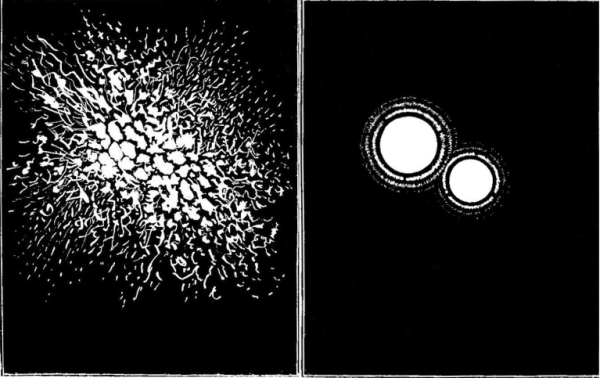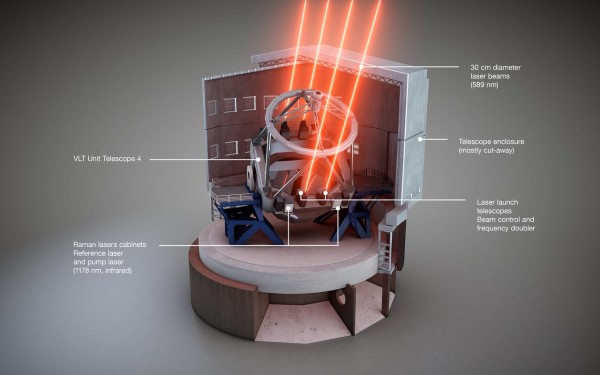"This event marks the culmination of many years of hard work on behalf of all involved." -Jane Bachynski
If you want to take an ideal image of the Universe, you need to not only minimize your light pollution, cloud cover and build the largest-aperture telescope you can, you also need to take away as much of the atmospheric distortion as you can.
 The effects of the Earth’s Atmosphere on the Telescopic Image of alpha Piscium from Edinburgh and from Alta Vista 10,700 ft., compared. From a 1863 engraving by Charles Piazzi Smyth, in the public domain.
The effects of the Earth’s Atmosphere on the Telescopic Image of alpha Piscium from Edinburgh and from Alta Vista 10,700 ft., compared. From a 1863 engraving by Charles Piazzi Smyth, in the public domain.
Typically, this involved building your telescopes at as high an altitude as possible, or ideally, going to space. However, adaptive optics technology recently (in 2012) surpassed the Hubble Space Telescope in at least some circumstances, and the latest development, of the 4 Laser Guide Star Facility (4LGSF), is poised to blow the old records out of the water.
Go get the full story on this amazing new system at Paranal Observatory!


I would expect the quide stars to be doubly distorted, as the light takes two trips (up and down), whereas the starlight is only distorted by a wayway trip. But, I guess the software can cope with this extra complexity.
Now how does the detector/computer combo, know which portions are delayed/advanced, from only looking at one image (unless its actually measuring the arrival time from a concentrated pule -which I really really doubt is possible)? Or is it just trying a bunch of perturbations and seeing what happens, or is their something really clever going on?
@Omega #1: See the section on guide stars in the "Adaptive Optics" Wikipedia article. The upward path is irrelevant -- the laser is used to excite sodium ion emission at a particular point in the upper atmosphere. It's the image of that excitation spot which gets distorted. The distorted wavefront is imaged by a complex multilens optical system, and the pattern is used to set inverse distortions in the telescope's mirrors.
The best thing about the technology is that it will soon be possible for the backyard operator to run a similar setup in small scale. A 36 to 40 inch reflector in a dome is not out of the question in the near future. The cost of sodium lasers will eventually drop with demand. Quite a challenge, methinks.
@PJ #3
The cost of sodium lasers is likely to drop but the adaptive optics required to make use of a quad-beam guide star is likely to remain cost prohibitive. The far better bet for the backyard operator is in Lucky Imaging. It works great with regular mirrors, but even if low-order AO becomes a financial possibility for amateur astronomers, it does pair nicely with lucky imaging. They use such a set up on our local 200 inch telescope and the paired technologies are producing some incredible images.
http://www.adaptiveoptics.org/News_0907_1.html
@PJ and Denier: Amateur adaptive optics already exists! Take a look at http://www.sbig.com/about-us/blog/differential/, for instance. A Google search for "DIY adaptive optics" suggests that SBIG is the main player, but there are other companies out there as well.
Technologically, it should be possible today for a skilled amateur to actual build an adaptive mirror/guide star system. An Arduino or Raspberry Pi can very easily drive small (plastic) linear actuators attached to either mirror segments or even a membrane mirror (something thicker than Mylar for stability, but still flexible). Wavefront sensors (what you use with a guide star) are available from many vendors. The algorithms to do the wavefront analysis is available in the scientific literature.
Lucky imaging is a very cool alternative to physical AO, but I'm not sure whether it's applicable to some areas of interest to amateur astronometers, in particular variable stars and transients.
Given that AO 8 from sbig is around 700$... that's quite affordable for backyard astronomy.
The skill needed to put VLT style adaptive optics (even if cost permits) is such that I wouldn't consider that amateur astronomer/engineer. That's a pro to me, even if he/she doesn't work as a professional astronomer. But lucky imaging as ccd paired with below 1k$ AO is very cool for below 10k$ setup.
Another breakthrough might be coming in domain of post-production. The latest generation of Adobe's sharpening algorithms are mind blowing. They are able to decode the motion of the lens in motion blurred images etc... so even without AO, we might be able to get much more sharpness in post, with quality unimaginable just 2-3 years ago
p.s. one thing about SBIG and others in the industry... I would love if they all stopped using serial port connections... i mean.. it's 21st century for crying out loud... wake up and take the damn USB. lol
Golly gosh! Seems like I have gotten lost with the latest amateur info re adaptive optics. Thanks, guys, for all the good info. DIY looks like the way forward (for me, at least).
It's a long way from the old days of taking moon photo's; waiting for the image to clear from atmospheric aberrations, take the shot, wait for the next clear moment, take the next shot, etc.
Progress, eh?
:)